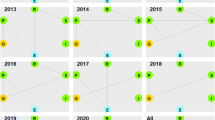Abstract
The present paper deals with the question whether “Gibrat's law” is applicable to Italian mechanical companies active between 1997 and 1999 or not. The analysis was carried out at a spatial level splitting companies in four macro-regions: North-West, North-East, Centre and South. On the basis of a set of descriptive and inferential tools, we find that firm size, measured by total assets, follows approximately a log-normal distribution in at least two of the four analyzed macro-regions. Nevertheless log-normality is only one necessary but not sufficient condition for the validity of the Gibrat's law. Thus we analyzed the influence of firm size on growth rate finding a negative relation between the two variables in all macro-regions. This is a clear violation of Gibrat's law. Another violation was found by the application of an econometric model which evidences the persistence of growth.
Similar content being viewed by others
References
Agresti A (2002) Categorical Data Analysis, (2nd edn.): Wiley, New Jersey
Almus M, Nerlinger EA (2000) Testing “Gibrat's” for young firms-empirical results for West Germany. Small Business Economics 15: 1–12
Amaral LAN, Buldyrev SW, Havlin S, Leschhorn H, Maass P, Salinger MA, Stanley HE, Stanley MHR (1997) Scaling behaviour in economics: I. Empirical results for company growth. Journal De Physique I 7: 621–633
Audretsch DB, Klomp L, Thurik AR (2002) Gibrat's law: are the services different? Erim Report Series Research Management, Erasmus Research Institute of Management, University of Rotterdam
Barca F (1985) Tendenze nella struttura dimensionale dell'industria italiana: una verifica empirica del “modello di specializzazione flessibile”. Politica Economica 1: 71–109
Barca F, Magnani M (1989) L'industria tra capitale e lavoro. II Mulino, Bologna
Barnett V, Lewis T (1994) Outliers in Statistical Data, John Wiley, New York
Becchetti L, Trovato G (2002) The determinants of growth for small and medium sized firms. The role of the availability of external finance. Small Business economics 19: 291–306
Boeri T (1989) Does firm size matter? Giornale degli Economisti e Annali di Economia 43: 477–495
Bottazzi G (2001) Firm diversification and the law of proportionate effect. Working Paper n.1, http://www.sssup.it
Bottazzi G, Cefis E, Dosi G (2002) Corporate growth and industrial structures: some evidence from the Italian manufacturing industry. Industrial and Corporate Change 11: 705–723
Bowman AW, Azzalini A (1997) Applied Smoothing Techniques for Data Analysis: the Kernel Approach with S-Plus Illustrations. Oxford University Press, Oxford
Cabral L, Mata J (2003) On the evolution of the firm size distribution: Facts and theory. The American Economic Review 93: 1075–1090
Caves R (1998) Industrial organization and new findings on the turnover and mobility of firms. Journal of Economic Literature 36: 1947–1982
Chesher A (1979) Testing the law of proportionate effect. The Journal of Industrial Economics 27: 403–411
Efron B (1981) Censored data and the bootstrap. Journal of the American Statistical Association 76: 312–319
Evans DS (1987) Tests of alternative theories of firm growth. Journal of Political Economy 95: 657–674
Fagiolo G, Luzzi A (2004) Do liquidity constraints matter in explaining firm size and growth? Some evidence from the Italian manufacturing industry. (Unpublished Manuscript)
Gagliardi C (2000) Lo stato di attuazione del REA. IN: Quintano C. (a cura di) Scritti di Statistica Economica 6, Atti dell'incontro su Stato ed evoluzione delle fonti amministrative per il sistema delle statistiche economiche, Liguori, Napoli, Versione CD ROM
Ganugi P, Grossi L, Gozzi G, Gagliardi C (2002) Growth with statistical regularity: the Italian New Economy. Proceedings of IOAS 2002: Official Statistics and the New Economy, Londra 27–29 Agosto 2002
Ganugi P, Grossi L, Crosato L (2003) Firm size distribution and stochastic growth models: a comparison between ICT and mechanical Italian companies. Statistical Methods and Applications 12(3): 391–414
Geroski P (2000) The growth of firms in theory and practice. In: Foss N, Mahnke V (eds) Competence, Governance and Entrepreneurship. Oxford University Press, Oxford
Gibrat R (1931) Les inégalités économiques. Librairie du Recrueil Sirey, Paris
Green WH (1993) Econometric Analysis, 2nd edn. McMillan Publishing Company, New York
Hall BH (1987) The relationship between firm size and firm growth in the U.S. manufacturing sector. Journal of Industrial Economics 35: 583–606
Ijiri Y, Simon HA (1977) Departures from the Pareto distribution. In: Ijiri Y, Simon HA (eds) Skew distributions and the size of business firms. North Holland, Amsterdam
Kalecki M (1945) On the Gibrat distribution. Econometrica13: 161–170
Kumar MS (1985) Growth, acquisition activity and firm size: evidence from the United Kingdom. The Journal of Industrial Economics 33: 327–338
Leti G (1983) Statistica descrittiva. Il Mulino, Bologna
Lotti F, Santarelli E (2001) Industry dynamics and the distribution of firm sizes: A non-parametric approach. Working Paper 406, Dipartimento di scienze Economiche Università degli Studi di Bologna
Lotti F, Santarelli E, Vivarelli M (2003) Does Gibrat's law hold among young, small firms? Journal of Evolutionary Economics 13: 213–235
McCloughan P (1995) Simulation of concentration development from modified Gibrat growth-entry-exit processes. The Journal of Industrial Economics 18: 405–433
Pagan A, Ullah A (1999) Non parametric Econometrics Cambridge University Press, Cambridge
Quandt RE (1966) On the size distribution of firms: American Economic Review 56: 416–432
Silverman BW (1986) Density estimation for statistics and data analysis. Chapman & Hall, London
Simon HA, Bonini CP (1977) The size distribution of business firms. In: Ijri Y, Simon HA (eds) Skew distributions and the size of business firms. North Holland, Amsterdam
Singh A, Whittington G (1975) The size and growth of firms. Review of Economic Studies 42: 15–26
Steindl J (1965) Random processes and the growth of firms: a study of Pareto law. Griffin, London
Theil H (1971) Principles of Econometrics. Wiley & Sons, New York
Author information
Authors and Affiliations
Rights and permissions
About this article
Cite this article
Ganugi, P., Grossi, L. & Gozzi, G. Testing Gibrat's law in Italian macro-regions: Analysis on a panel of mechanical companies. Statistical Methods & Applications 14, 101–126 (2005). https://doi.org/10.1007/BF02511577
Issue Date:
DOI: https://doi.org/10.1007/BF02511577




